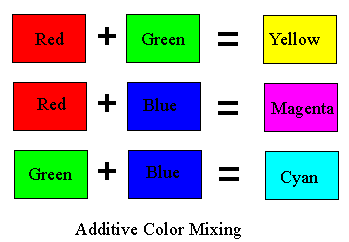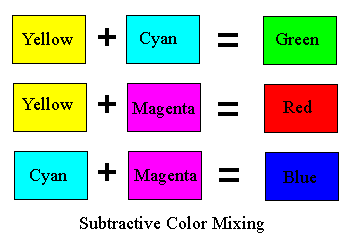 Additive color mixing: When white light is put through a spectrometer, for example a simple prism, it is broken down into the colors of the rainbow, and as a consequence when you mix all the color of the rainbow together , you get white light. However Newton showed that any color in the rainbow can be created from a mixture the three primary colors Red, Green, and Blue. Vision, movies, TV, and CRT devices, such as your computer screen, depend on additive color mixing to make all the possible colors.
Additive color mixing: When white light is put through a spectrometer, for example a simple prism, it is broken down into the colors of the rainbow, and as a consequence when you mix all the color of the rainbow together , you get white light. However Newton showed that any color in the rainbow can be created from a mixture the three primary colors Red, Green, and Blue. Vision, movies, TV, and CRT devices, such as your computer screen, depend on additive color mixing to make all the possible colors.
For example equal mixtures of green and red add to make yellow, and equal mixtures of blue and red add to make magenta. In the applet on the next page, you can play around with various mixtures of the three additive primary colors to make any color you want.
The cones of the eye, as opposed to the rods, are color sensitive. One theory is that there are three types of cones which has sensitivity in the red, green, and blue regions of the spectrum. For example when the red and green cones are equally stimulated, the brain perceives yellow.
 Subtractive color mixing: If you own a printer for your computer system, you may have wondered why the ink cartridges you buy come in a peculiar color variety Cyan, Magenta, Yellow, and Black. The answer is that the first three of these are the subtractive color primaries. the colors you need for viewing of reflected images. Why does an object appear to be a certain color when it illuminated by white light? Because that color is what is reflected by the dress, skin, painted surface, illustration, etc. In other words a colored surface absorbs certain colors and reflects the rest. The two colors, absorbed and reflected, are said to be complementary. When added together they give white.
Subtractive color mixing: If you own a printer for your computer system, you may have wondered why the ink cartridges you buy come in a peculiar color variety Cyan, Magenta, Yellow, and Black. The answer is that the first three of these are the subtractive color primaries. the colors you need for viewing of reflected images. Why does an object appear to be a certain color when it illuminated by white light? Because that color is what is reflected by the dress, skin, painted surface, illustration, etc. In other words a colored surface absorbs certain colors and reflects the rest. The two colors, absorbed and reflected, are said to be complementary. When added together they give white.
The color cyan is white with the red removed. Cyan and red are complementary colors. A cyan surface absorbs red, just as a magenta surface absorbs green, and a yellow surface absorbs blue. If you shine red light on a yellow surface, it will appear black. You can make a surface appear any color in the visible spectrum by absorbing different amounts of red, green and blue with cyan, magenta, and yellow pigments. In the applet on the next page, you can play around with various mixtures of the three subtractive primary colors to make any color you want. Note that an equal mixture of the three primary subtractive colors absorbs red, green, and blue, and therefore appears black. However, this is not an effective way to print in black because you use a lot of ink and the final result often has a color cast. That is why you also purchased a black cartridge separately. Note that modern printers do a very good job a recreating all the colors in a photograph with the three subtractive primaries and black. This is usually called CMYK printing. More demanding printing technologies use more pigments to be able to reproduce the original colors with even greater accuracy.
Filters: Colored filters are often used in photography and other technical applications. For example many telescope pictures of the sky were taken with black and white film and three filters (RGB). The name of a filter usually refers to the color that is transmitted. So for example a yellow filter when illuminated with white light would pass green and red while absorbing blue. Blue light will not go through a yellow filter.
© MultiMedia Physics 2000